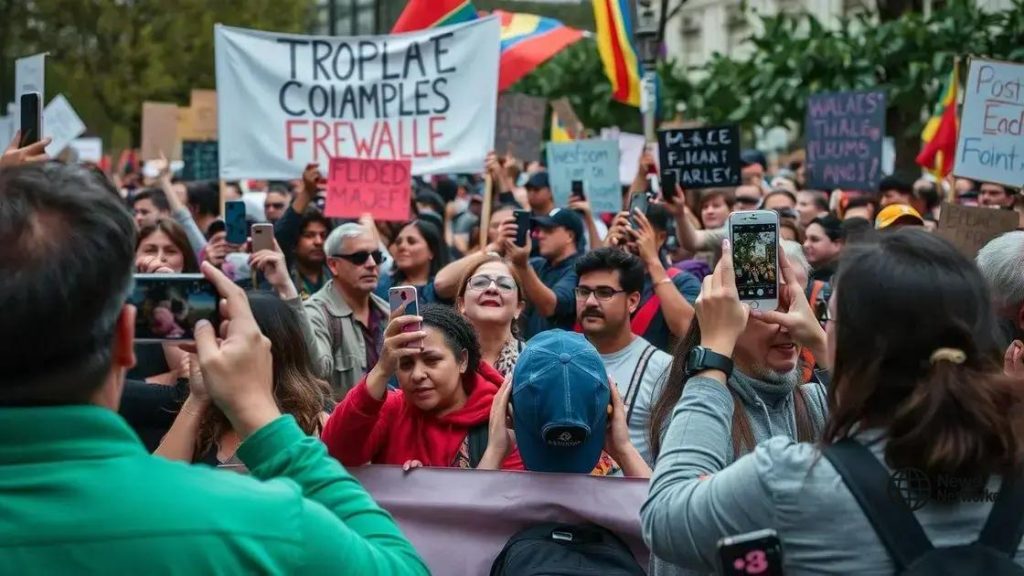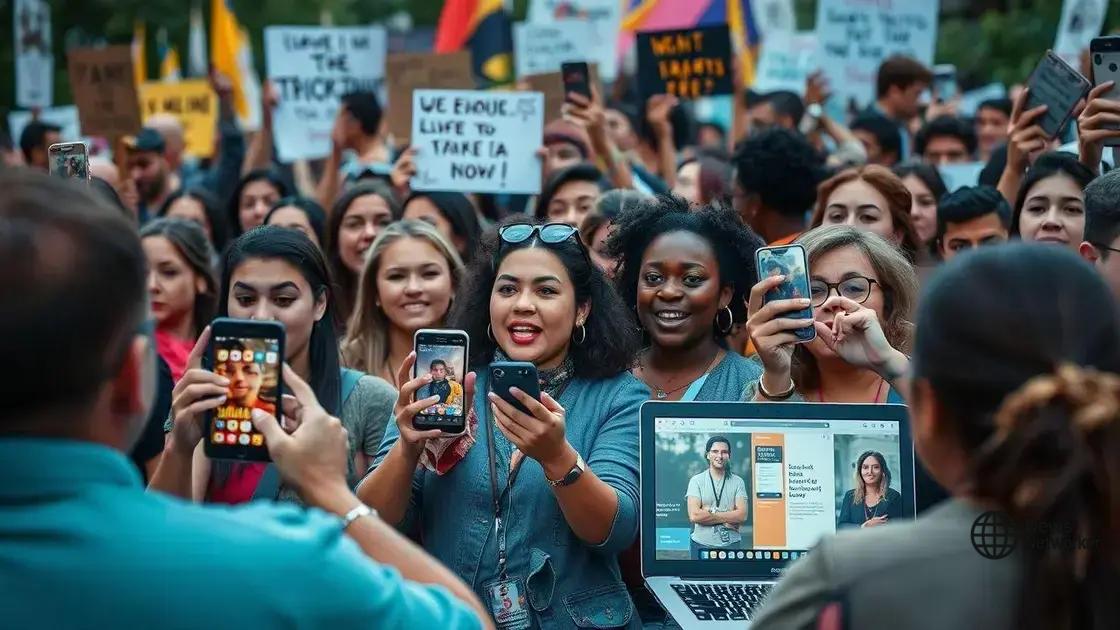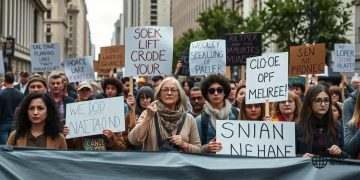Visual media in protest documentation: capturing the moment

Visual media in protest documentation plays a critical role by creating emotional connections, increasing visibility, and driving social change through powerful images and videos that resonate with audiences.
Visual media in protest documentation plays a crucial role in shaping perceptions and memories of social movements. Have you ever wondered how a single image or video can capture the heart of a cause? Let’s dive into the transformative power of visuals in activism.
The role of photography in documenting protests
The role of photography in documenting protests cannot be overstated. Through powerful images, stories unfold that resonate across the globe. A photograph can capture moments of struggle, triumph, and human connection in a way that words often cannot.
Visual impact and storytelling
Each photograph taken during a protest adds to a larger narrative. Images capture the emotion of the moment, conveying feelings that might be overlooked in written reports. When people see a striking image of a protestor’s face, they feel a connection. This emotional impact can inspire others to join the cause or take action.
Photos as historical documents
Photographs serve as vital records of events as they unfold. They help preserve the truth about what happens during protests, creating a visual timeline for future generations. Many significant historical events are remembered not just through texts but through memorable photos that illustrate the intensity and purpose of the movements.
- They highlight the diversity of protesters.
- They showcase the scale and urgency of the events.
- They can reveal moments of solidarity and support.
Moreover, these images often circulate on social media, broadening their reach and influence. A well-captured photo can be shared thousands of times, spreading awareness far beyond the initial location of the protest.
Beyond merely showing protest scenes, photography emphasizes the humanity behind the movements. It showcases the expressions, actions, and interactions of individuals involved, ensuring their voices are heard. This visual representation is crucial in creating empathy and understanding, making the themes of justice and equality accessible to everyone.
Ethics in protest photography
Yet, it’s important to consider ethics in protest photography. Photographers must be respectful and aware of their surroundings. Consent is essential, especially when capturing vulnerable moments. By prioritizing the dignity of individuals, photographers can create compelling narratives that honor the cause and the people behind it.
In conclusion, the role of photography in documenting protests extends beyond mere images. It shapes public perception, creates historical records, and emphasizes the emotional weight of social movements. As we continue to engage with these powerful visuals, we reinforce the importance of storytelling through photography in the fight for change.
Video footage: preserving moments of change
Video footage plays a vital role in preserving moments of change during protests. Through moving images, powerful stories unfold that resonate widely. Unlike photographs, videos capture not just the scene but also the emotions and sounds, providing a richer understanding of the situation.
Dynamic storytelling in action
The magic of video lies in its ability to convey action and reaction in real-time. When you watch a protest unfold on video, you experience the tension, excitement, and urgency as it happens. This dynamic nature makes video footage a compelling medium for storytelling, enabling viewers to connect with the moment in ways that static images might not achieve.
The importance of live streaming
Live streaming has revolutionized how protests are documented. It allows anyone with a smartphone to broadcast events as they happen, bringing real-time awareness to people worldwide. This can mobilize support quickly and amplify voices that might otherwise go unheard.
- Instant visibility of events.
- Engagement with a global audience.
- Real-time updates from different perspectives.
Moreover, videos retain context lost in a single photograph. The gestures, the speeches, and the reactions of the crowd all contribute to the narrative. By analyzing the footage, viewers can better understand the motivations and goals of the protesters, showing the full scope of the movement.
Furthermore, video documentation serves as a tool for accountability. When people see evidence of police actions or public responses, it can foster transparency and provoke discussions around justice. This transparency is crucial in advocating for change.
Ethical considerations in filming
While capturing important moments, it’s essential to consider ethics. Filmmakers should respect the individuals being filmed, ensuring their safety and privacy. Seeking consent is fundamental, especially in sensitive situations, as the impacts of video can be profound and long-lasting.
In summary, video footage is a powerful means of preserving moments of change during protests. It enhances our understanding of social movements and amplifies voices seeking justice. Through strong storytelling and ethical practices, video can move audiences and inspire action.
Social media’s influence on protest visibility

Social media’s influence on protest visibility is immense in today’s interconnected world. Platforms like Twitter, Facebook, and Instagram allow users to share and amplify voices quickly and efficiently. Through social media, information spreads at lightning speed, transforming grassroots movements into global phenomena.
The rapid dissemination of information
When a protest occurs, it can be live-streamed and shared with a large audience almost instantly. Hashtags play a crucial role in gathering momentum for causes. They organize conversations and help users find content related to specific movements. This creates a sense of urgency and community, drawing more participants to the cause.
A platform for marginalized voices
Social media offers a powerful platform, allowing marginalized groups to share their stories and experiences. It empowers individuals to speak out without traditional media filters. This democratization of information is vital for highlighting issues that mainstream outlets might overlook.
- Increased engagement with a wider audience.
- Facilitation of virtual activism and support.
- Creation of digital communities centered around shared causes.
Moreover, social media campaigns can raise awareness about issues that may not have received attention otherwise. For instance, viral posts can lead to donations, petitions, and solidarity from people worldwide. These platforms also serve as a source of real-time updates from the ground, offering context that traditional news outlets may miss.
However, the influence of social media is not solely positive. Misinformation can spread just as rapidly, leading to misunderstandings about the goals and methods of protesters. This highlights the need for critical thinking and verification of information shared online.
Building solidarity and action
Ultimately, social media fosters a sense of global solidarity among protestors. When individuals see others standing up for their rights, it can inspire them to take action in their own communities. The shared experiences and stories create connections that transcend geographical boundaries, strengthening movements worldwide.
In summary, social media’s influence on protest visibility is profound. It amplifies messages, engages audiences, and democratizes storytelling, making it a critical tool for modern activism.
Analyzing the impact of visual storytelling
Analyzing the impact of visual storytelling reveals its immense power in shaping perceptions and inspiring action. Images and videos can convey messages that words often struggle to capture. They evoke emotions, provoke thoughts, and connect individuals to causes in a profound way.
The emotional connection through visuals
Visual storytelling taps into our emotions. When we see a photo or video that resonates, it can trigger feelings of empathy and solidarity. This emotional response is crucial for inspiring individuals to engage with social issues. A compelling image can tell a story that lingers in our minds long after we’ve seen it.
Creating memorable narratives
Effective visuals can create powerful narratives. A single image can encapsulate the essence of a protest, conveying its motivation and urgency. These narratives help drive movements forward by making messages relatable and memorable. Viewers are more likely to share stories that touch their hearts or challenge their beliefs.
- Enhances audience engagement.
- Facilitates deeper understanding of issues.
- Encourages sharing and activism.
Moreover, visual storytelling can serve educational purposes. It can highlight injustices and raise awareness about critical social issues. Effective visuals often lead to discussions and reflections, prompting viewers to think critically about the world around them.
In addition, the accessibility of visual content allows it to reach diverse audiences. People from various backgrounds can connect with images and videos, bridging gaps and fostering dialogues. This universality is a strength of visual storytelling, as it transcends language barriers and resonates across cultures.
The role of visual media in social change
Ultimately, the impact of visual storytelling in driving social change is significant. It harnesses the power of imagery to advocate for justice and equality. When combined with strategic messaging on social media, visuals can mobilize support and action effectively.
As we analyze the impact of visual storytelling, it becomes clear that these elements are more than just aesthetics. They form the backbone of movements, inspiring people to take a stand and make a difference.
Case studies of iconic protest images
Case studies of iconic protest images reveal how powerful visuals can influence public opinion and drive social change. These images capture pivotal moments in history, demonstrating the profound impact of visual storytelling during protests.
The power of ‘Tank Man’
One of the most famous protest images is the “Tank Man” photograph taken during the Tiananmen Square protests in 1989. It depicts a lone man standing in front of a column of tanks, symbolizing bravery against oppressive forces. This image quickly became a global symbol of resistance and sparked discussions about human rights and freedom.
The ‘I Am A Man’ photo
An iconic image from the Civil Rights Movement is the “I Am A Man” photograph taken during the Memphis sanitation workers’ strike in 1968. The image portrays a group of workers holding powerful signs, showcasing their demand for dignity and fair treatment. This visual helped spotlight labor rights and equality, resonating with many and motivating further action.
- Highlighting personal struggles and community resilience.
- Creating a rallying point for movements.
- Influencing policy changes and social perceptions.
Another impactful image is the “V for Vendetta” mask popularized during the Occupy movement. Initially a symbol from a film, it became a powerful representation of anonymity and collective protest against corruption and corporate greed. This mask shows how an image can evolve, becoming a potent emblem of a larger movement.
These case studies emphasize that iconic protest images don’t just capture events; they can also evoke emotions, provoke reactions, and mobilize people to action. Each image tells a story, inviting viewers to engage with the issues at hand actively.
The lasting legacy of protest photography
Visuals from protests often inspire future generations to continue the fight for change. They serve as reminders of what has been achieved and what still needs to be done. The legacy of these images helps maintain momentum for ongoing struggles across the globe.
By examining these case studies, we can understand how iconic protest images shape culture and consciousness, becoming integral parts of our collective memory that drive progress.
FAQ – Frequently Asked Questions about Visual Media in Protest Documentation
How do iconic protest images influence public perception?
Iconic protest images shape public perception by evoking strong emotional responses and creating memorable narratives that resonate with audiences.
What role does social media play in protest visibility?
Social media amplifies protest visibility by allowing real-time sharing and engagement, making it easier for marginalized voices to be heard globally.
Why are video footages important in documenting protests?
Video footage captures the dynamics of protests, providing context and emotion that still images may miss, making the experience more relatable to viewers.
How can visual storytelling drive social change?
Visual storytelling drives social change by highlighting injustices, fostering empathy, and mobilizing people to take action for causes they care about.





